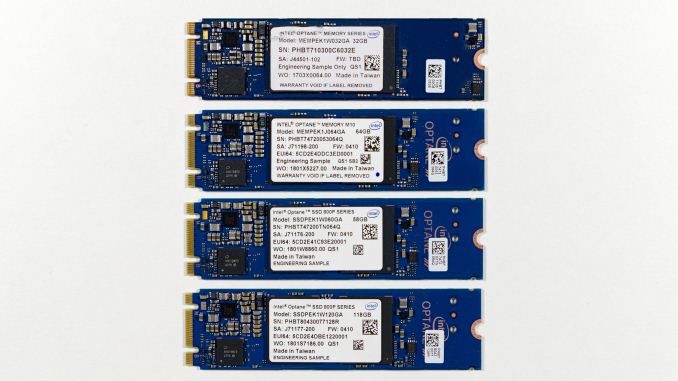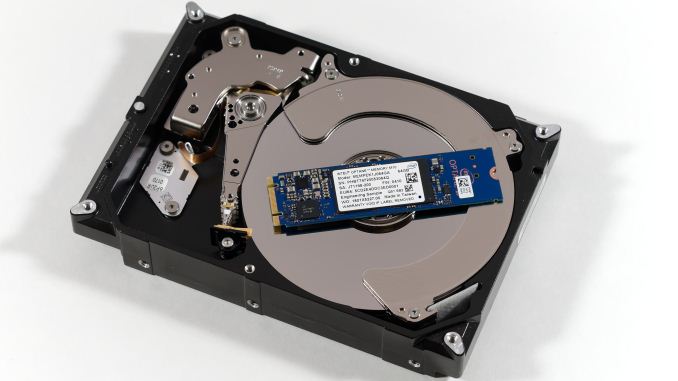The Intel Optane Memory M10 (64GB) Review: Optane Caching Refreshed
by Billy Tallis on May 15, 2018 10:45 AM EST- Posted in
- SSDs
- Storage
- Intel
- PCIe SSD
- SSD Caching
- M.2
- NVMe
- Optane
- Optane Memory
Conclusion: Going for a Data Cache
At the hardware level, the Optane Memory M10 is a simple and straightforward update to the original Optane Memory, bringing a new capacity that some users will appreciate, and power management that was sorely lacking from the original. On the software side, the experience is quite similar to the first iteration of Optane Caching that Intel released a year ago with their Kaby Lake platform. The only big user-visible change is the ability to cache non-boot drives. This corrects the other glaring omission, giving the Optane Memory system an overall impression of being a more mature product that Intel is taking seriously.
Optane Memory caching now seems to be limited primarily by the fundamental nature of SSD caching: not everything can fit in the cache. Occasional drops down to hard drive performance are more frequent and more noticeable than when a flash-based SSD's SLC write cache fills up, or when a M.2 SSD starts thermally throttling. Neither of those happens very often for real-world use, but cache misses are still inevitable.
The latency from a flash-based SSD tends to grow steadily as the workload gets more intense, up to the point that there isn't enough idle time for garbage collection. The performance of most modern flash-based SSDs degrades gracefully until the SLC cache fills up. The latency distribution from an Optane+hard drive cache setup looks very different: latency is excellent until you try to read the wrong block, then you have to wait just as long as in a hard drive-only setup.
The key to making SSD caching work well for desktop use is thus to ensure that the cache is big enough for the workload. For relatively light workloads, the 32GB Optane Memory is often sufficient, and even the $25 16GB module that we haven't tested should offer a noticeable improvement in system responsiveness. For users with heavier workloads, the larger 64GB Optane Memory M10 and even the 118GB Optane SSD 800P may not be big enough, and the price starts getting close to that of a good and reasonably large SATA SSD.
For power users, the data drive acceleration mode is more appealing. A gamer might want to use a 256GB or 512GB SATA SSD for the OS and most programs and documents, but would need a 1TB or larger drive for his entire Steam library. A 1TB 7200RPM hard drive plus the 64GB Optane Memory M10 or the 58GB Optane SSD 800P is cheaper than a good 1TB SATA SSD, and the cache is large enough to hold one or two games. A 2TB hard drive plus the 118GB Optane SSD 800P can cache the even the largest of AAA games and is no more expensive than the cheapest 2TB SATA drive. For capacities beyond that, caching only gets more appealing.
Our SYSmark testing showed that for many common tasks, adding even a 32GB cache to a hard drive can bring performance up to the level of a SSD-only configuration. There are a lot of lightweight everyday workloads that can fit well in such a cache, and for those users the larger 64GB Optane Memory M10 doesn't bring worthwhile performance improvements over the 32GB Optane Memory.
On the other hand, it is clear that no amount of fast storage can make up for a system crippled by too little RAM, which is a disappointment in a time when SSDs are getting cheaper but RAM prices are still climbing. Optane SSDs may be the fastest swap devices money can buy, but they're no substitute for having adequate RAM. The 4GB low-end configuration we tested is simply not enough anymore, and for future storage caching tests we will consider 8GB as the absolute minimum requirement before any storage performance upgrades should be considered.
Our synthetic benchmarks of Intel's Optane Memory caching confirmed the most predictable effects of cache size compared to working set size, but didn't reveal many nuances of Intel's cache management strategies. There is clearly some overhead relative to accessing just the SSD, but not enough eliminate the fundamental performance advantages of 3D XPoint memory. There also appears to be some write caching and combining done with system RAM, trading a bit of safety for improved write performance beyond even what the Optane SSDs alone can handle. Whether it's advertised or not, this tends to be a feature of almost every third-party add-on software for storage acceleration. It's the simplest way to improve storage benchmark numbers and the tradeoffs are quite acceptable to many users.
The Optane Memory caching seems to be quite responsive to changes in usage patterns. One launch of an application is sufficient to bring its data into the cache, and Intel isn't shy about sending writes to the cache. It doesn't appear that the Optane Memory caching system does anything significant to reduce wear on the cache device, so Intel seems confident that these cache devices have plenty of write endurance.
| Intel Optane Product Lineup | |
| Capacity | Drives |
| 16 GB | Optane Memory (M.2) $24.99 ($1.56/GB) |
| 32 GB | Optane Memory (M.2) $58.91 ($1.84GB) |
| 58 GB 64 GB |
Optane SSD 800P (M.2) $111.48 ($1.92/GB) Optane Memory M10 $144 ($2.48/GB) |
| 118 GB | Optane SSD 800P (M.2) $196.43 ($1.66/GB) |
| 280 GB | Optane SSD 900P (AIC, U.2) $354.99 ($1.27GB) |
| 480 GB | Optane SSD 900P (AIC) 544.99 ($1.14/GB) Optane SSD 905P (U.2) $599.00 ($1.25/GB) |
| 960 GB | Optane SSD 905P (AIC) $1299.00 ($1.35/GB) |
Intel's 3D XPoint memory is clearly a far better media for small cache drives than NAND flash, but it is still afflicted by a very high price per GB. Only the 16GB Optane Memory at $25 seems like an easy purchase to make, but it is small enough that its performance potential is much more limited than the larger Optane products. The 64GB Optane Memory M10 is expensive enough that skipping caching altogether and going with just a SATA SSD has to be seriously considered, even when shopping for 1 or 2 TB of storage. In spite of the power management the Optane Memory M10 adds over the original cache module, it still doesn't seem like a hard drive plus a cache module makes any sense for mobile use. Optane prices need to come down faster than NAND prices in order for this caching strategy to gain wide acceptance. This doesn't seem likely to happen, so Optane Memory will remain a niche solution—but that niche is definitely not as small as it was when Optane Memory was first introduced.












96 Comments
View All Comments
TrackSmart - Tuesday, May 15, 2018 - link
People seem to be talking around each other in these threads, without actually reading the substance of each person's reply.Dr. Swag didn't mention ONLY using a 500GB SSD. Just the opposite. He/she was suggesting that you could use a 500GB SSD for both a boot drive AND a 64GB cache drive. So you end up with ~440GB of normal SSD space (enough for most programs) AND a ~60GB cache drive to speed up your HDD accesses. All for the same price as adding a 64GB optane drive.
Addressing Dr. Swag's actual comment: I partially agree. One downside to the arrangement you suggested is that most affordable SSDs have lower write endurance than cache drives. They are also likely to be slower than an optane drive (but still fast compared to HDDs). And if your SSD boot/cache all-in-one drive dies, you might lose data on both the SSD and the HDD.
Regarding WithoutWeakness: Your comment makes sense if you are accessing the same subset of data over-and-over again. But if you are accessing a block of data ONCE to run an analysis and then moving onto a new block of data, then you will experience HDD speeds. Same goes for the first access to the data in cases where you will be using it multiple times. Slow the first time, faster in future times. So the downsides of a small cache will remain in a number of scenarios.
I personally think that Intel missed the boat with Optane. These solutions would have been a lot more convincing when SSD storage was a lot more expensive (i.e. 5+ years ago) and before other caching options existed for making use of 'normal' SSDs.
ಬುಲ್ವಿಂಕಲ್ ಜೆ ಮೂಸ್ - Tuesday, May 15, 2018 - link
Power loss protection ?From what I know so far, the MX500 (500GB) cache contains unique data that has not yet been written to normal nand and Crucial does not recommend using an SLC cache unless you have battery backup protection
An Optane cache drive is a "copy" of data already on the hard drive (or SSD) and I don't see a problem with power loss resulting in data loss once you clear the cache
SkipPpe - Friday, May 18, 2018 - link
Something like an Intel 3510 would be a better drive to use for this.ಬುಲ್ವಿಂಕಲ್ ಜೆ ಮೂಸ್ - Tuesday, May 15, 2018 - link
DOH......Nevermind!
sharath.naik - Tuesday, May 15, 2018 - link
I was wondering if the lifespan of these are no better than SSD. wont this burn out much faster than the drives lifespan if used as a cache for it?MajGenRelativity - Tuesday, May 15, 2018 - link
Optane drives are more durable than the average SSDCheapSushi - Wednesday, May 16, 2018 - link
Even more so than MLC NAND, which seems to be getting harder and harder to find (aside from Samsung's PRO line).Drumsticks - Tuesday, May 15, 2018 - link
Is anybody else interested in the performance of the 800p as a cache drive? The difference between an Optane SSD 800p and a 1TB HDD versus a 1TB SATA drive nowadays is less than $15, so it's pretty comparable for effectively the same capacity of storage. On the other hand, in the 25 or so graphs presented in this review, the 118GB caching solution outperforms a SATA drive, sometimes handily, in 24 of them. The 25th is power consumption, and one of them has a single loss in run 1 of the latency measurement for the heavy test.Hell, sometimes that solution outperforms the 900p. Why would you pick a comparably priced 1TB SATA SSD over something like that? If you need less storage, a 500GB will perform even worse than a 1TB, and a 250GB would be even worse still. Going down in capacity on the Optane drive would still probably keep you in the range of the SATA drive, while leaving you with double or quadruple the capacity.
Giroro - Tuesday, May 15, 2018 - link
"58GB 800P is functionally identical to the 64GB M10 and both have the exact same usable capacity of 58,977,157,120 bytes."Hold on, either something is wrong or that is straight-up false advertisement, a new low that is far beyond how storage manufacturers usually inflate their capacity specs. Don't just breeze past the part where Intel may be illegally marketing this thing. As far as I know Optane doesn't use over-provisioning, and it definitely isn't the normal GiB/GB conversion issue or the typical "formatting" excuse that doesn't actually apply to solid state media, so what gives?
It has to be a mistake, right?
The_Assimilator - Wednesday, May 16, 2018 - link
> it definitely isn't the normal GiB/GB conversion issueActually, it is.